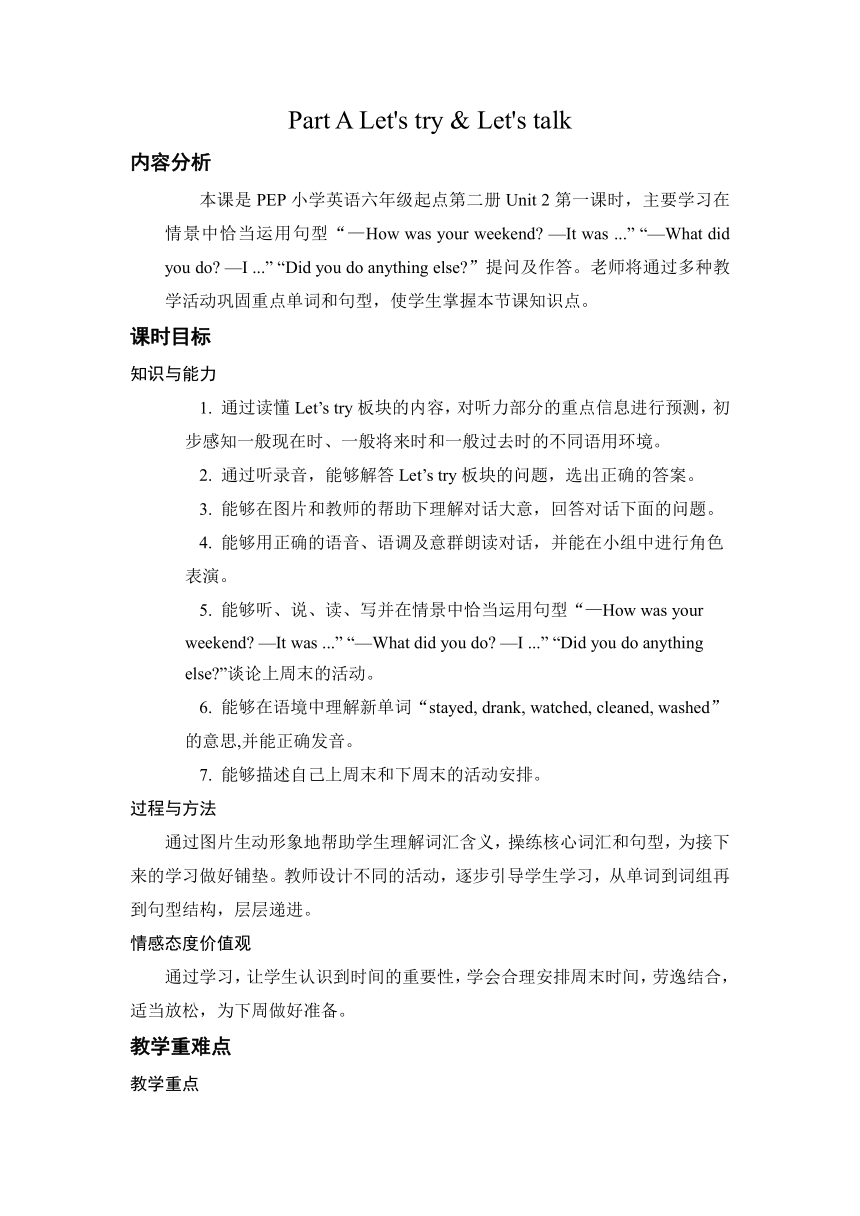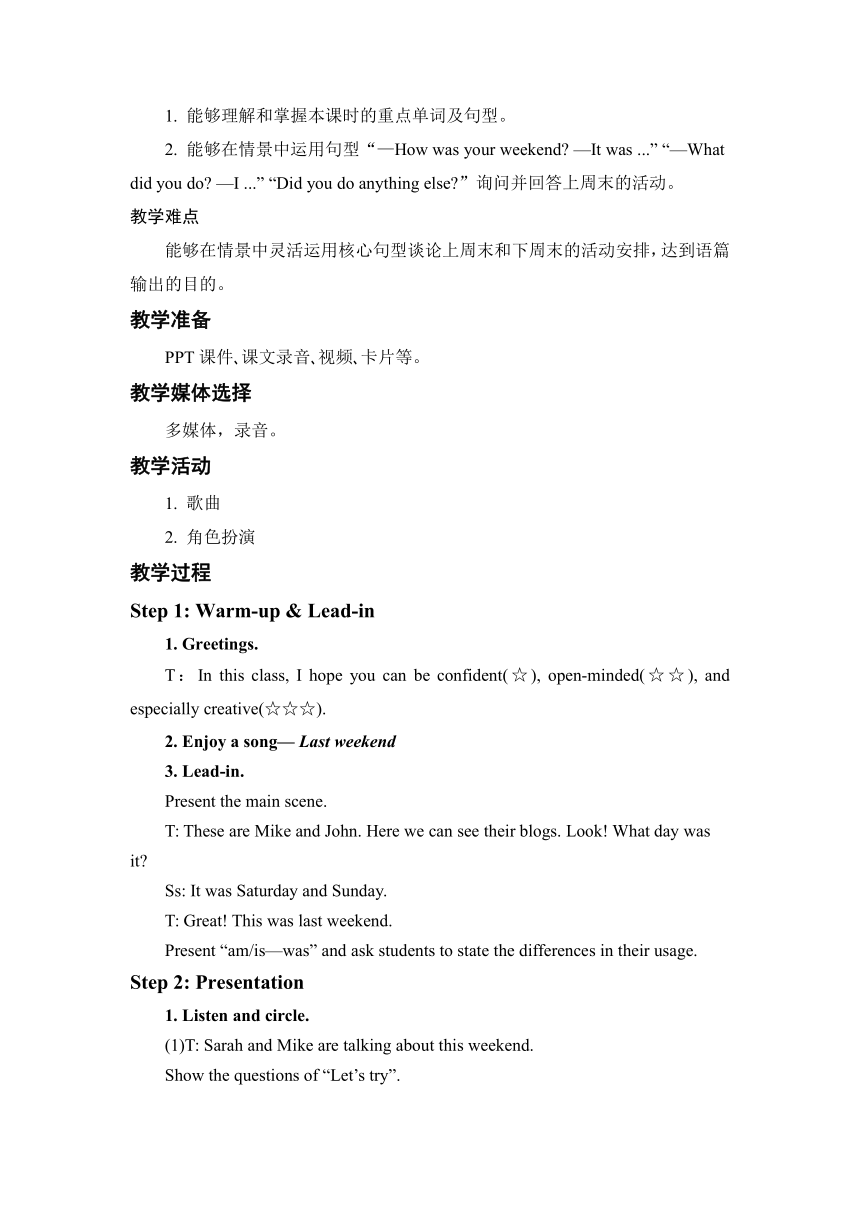Unit 2 Last weekend Part A Let's try & Let's talk 教案(含教学反思)
文档属性
| 名称 | Unit 2 Last weekend Part A Let's try & Let's talk 教案(含教学反思) |

|
|
| 格式 | docx | ||
| 文件大小 | 21.3KB | ||
| 资源类型 | 教案 | ||
| 版本资源 | 人教版(PEP) | ||
| 科目 | 英语 | ||
| 更新时间 | 2022-02-27 16:20:32 | ||
图片预览


文档简介
Part A Let's try & Let's talk
内容分析
本课是PEP小学英语六年级起点第二册Unit 2第一课时,主要学习在情景中恰当运用句型“—How was your weekend —It was ...” “—What did you do —I ...” “Did you do anything else ”提问及作答。老师将通过多种教学活动巩固重点单词和句型,使学生掌握本节课知识点。
课时目标
知识与能力
通过读懂Let’s try板块的内容,对听力部分的重点信息进行预测,初步感知一般现在时、一般将来时和一般过去时的不同语用环境。
通过听录音,能够解答Let’s try板块的问题,选出正确的答案。
能够在图片和教师的帮助下理解对话大意,回答对话下面的问题。
能够用正确的语音、语调及意群朗读对话,并能在小组中进行角色表演。
能够听、说、读、写并在情景中恰当运用句型“—How was your weekend —It was ...” “—What did you do —I ...” “Did you do anything else ”谈论上周末的活动。
能够在语境中理解新单词“stayed, drank, watched, cleaned, washed”的意思,并能正确发音。
能够描述自己上周末和下周末的活动安排。
过程与方法
通过图片生动形象地帮助学生理解词汇含义,操练核心词汇和句型,为接下来的学习做好铺垫。教师设计不同的活动,逐步引导学生学习,从单词到词组再到句型结构,层层递进。
情感态度价值观
通过学习,让学生认识到时间的重要性,学会合理安排周末时间,劳逸结合,适当放松,为下周做好准备。
教学重难点
教学重点
1. 能够理解和掌握本课时的重点单词及句型。
2. 能够在情景中运用句型“—How was your weekend —It was ...” “—What did you do —I ...” “Did you do anything else ”询问并回答上周末的活动。
教学难点
能够在情景中灵活运用核心句型谈论上周末和下周末的活动安排,达到语篇输出的目的。
教学准备
PPT课件 课文录音 视频 卡片等。
教学媒体选择
多媒体,录音。
教学活动
歌曲
角色扮演
教学过程
Step 1: Warm-up & Lead-in
1. Greetings.
T:In this class, I hope you can be confident(☆), open-minded(☆☆), and especially creative(☆☆☆).
2. Enjoy a song— Last weekend
3. Lead-in.
Present the main scene.
T: These are Mike and John. Here we can see their blogs. Look! What day was it
Ss: It was Saturday and Sunday.
T: Great! This was last weekend.
Present “am/is—was” and ask students to state the differences in their usage.
Step 2: Presentation
1. Listen and circle.
(1)T: Sarah and Mike are talking about this weekend.
Show the questions of “Let’s try”.
Lead students to predict and guess the key words.
(2) Play the recording of “Let’s try”. Let students try to circle the right answers.
(3) Students read the dialogue and check the answers.
Then ask two students to tell their judging clues.
Q1:Sarah and Mike are talking on Sunday, because Sarah said “Tomorrow is Monday.”
Q2: Mike is going to call his grandparents, because Mike said “I’m going to call my grandparents.”
Highlight the key sentences of the dialogue. Ask students to learn to read and lead them to understand the simple future tense.
(4)T: Mike said his weekend was great. What did he do last weekend
Ss: He cleaned his room and watched TV.
Present the activities Mike did last weekend. Read the new words. Lead students to distinguish the simple past tense from the simple present tense.
2. Watch and answer.
T: Mike is talking with his grandpa on the phone. Watch the video of “Let’s talk” and answer: What are they talking about
Ss: They are talking about their weekends.
T: How was Mike’s grandpa’s weekend
Ss: It was great.
T: We can also say “It was good/fine/OK/fantastic/wonderful/nice…
Teach the sentences “—How was Mike’s grandpa’s weekend —It was…”
3. Read and answer.
(1) Students read the dialogue and answer what Mike’s grandpa/ Mike did last weekend.
(2) Observe and summarize.
T: Observe the word-formation of the verbs. What’s in common
Students express the clues they find out.
Then the teacher makes a brief summary: the usage and the word-formation of the simple past tense.
Highlight the unusual word-formation of the word “drank”.
(3) Teach the sentences “—What did you do last weekend —I cleaned my room/ watched TV/ drank tea.” Let students pay attention to the past tense of verbs.
4. Get more details.
(1)T: Mike’s grandpa drank tea in the afternoon. Maybe he likes tea. Did you drink tea last weekend What else did you drink
Ss: Yes, I did. I drank some water/ milk/ juice/ cola/ coffee… / No, I didn’t.
Present “else” and the key sentence structure “What else did you… ”. Lead students to read them correctly.
(2)T: Mike and his grandpa both watched TV last weekend. What TV program did Mike watch
Ss: He watched some children’s shows on TV.
T: Do you like children’s shows What TV program did you watch last weekend
Ss: Yes, I do. I watched cartoons/sports programs/a film… /No, I don’t.
Step 3: Practice
1. Practice.
Show the key words and sentences in this period.
2. Read and act.
(1)Let students listen and read after the recording.Remind them to pay attention to the pronunciation and the intonation.
(2)Let students practice the dialogue in pairs.
(3)Act out.
3. Fill the blanks.
Lead students to fill in the blanks according to the context.
Firstly, make a model.
Then let students work in pairs.
At last, check the answers.
Step 4: Consolidation & Extension
1. Read and act.
(1)Let students listen and read after the recording.Remind them to pay attention to the pronunciation and the intonation.
(2)Let students practice the dialogue in pairs.
(3)Act out.
2. Can you say
T: Can you complete the whole dialogue
Lead students to fill in the blanks according to the context. Firstly, make a model. Then let students work in pairs.
At last, check the answers.
板书设计
Unit 2 Last weekend
stay—stayed watched—watched clean—cleaned
How was your weekend I’m fine.
What did you do I...
Did you... Yes/No.
作业设计
学会唱本课歌曲
教学反思
1. 由歌曲引入,带领学生预习新知,激发学生的学习兴趣。
2. 呈现活动设计丰富,易操作,且具备层次感,有效地提升了学生的核心素养。
3. 以学生为本,以解决问题为导向,引导学生自主学习。
4. 突出语用功能,联系学生生活中的实际情况,设置多个环节,环环相扣,层层深入,帮助学生在真实情景中自然地使用所学语言。
内容分析
本课是PEP小学英语六年级起点第二册Unit 2第一课时,主要学习在情景中恰当运用句型“—How was your weekend —It was ...” “—What did you do —I ...” “Did you do anything else ”提问及作答。老师将通过多种教学活动巩固重点单词和句型,使学生掌握本节课知识点。
课时目标
知识与能力
通过读懂Let’s try板块的内容,对听力部分的重点信息进行预测,初步感知一般现在时、一般将来时和一般过去时的不同语用环境。
通过听录音,能够解答Let’s try板块的问题,选出正确的答案。
能够在图片和教师的帮助下理解对话大意,回答对话下面的问题。
能够用正确的语音、语调及意群朗读对话,并能在小组中进行角色表演。
能够听、说、读、写并在情景中恰当运用句型“—How was your weekend —It was ...” “—What did you do —I ...” “Did you do anything else ”谈论上周末的活动。
能够在语境中理解新单词“stayed, drank, watched, cleaned, washed”的意思,并能正确发音。
能够描述自己上周末和下周末的活动安排。
过程与方法
通过图片生动形象地帮助学生理解词汇含义,操练核心词汇和句型,为接下来的学习做好铺垫。教师设计不同的活动,逐步引导学生学习,从单词到词组再到句型结构,层层递进。
情感态度价值观
通过学习,让学生认识到时间的重要性,学会合理安排周末时间,劳逸结合,适当放松,为下周做好准备。
教学重难点
教学重点
1. 能够理解和掌握本课时的重点单词及句型。
2. 能够在情景中运用句型“—How was your weekend —It was ...” “—What did you do —I ...” “Did you do anything else ”询问并回答上周末的活动。
教学难点
能够在情景中灵活运用核心句型谈论上周末和下周末的活动安排,达到语篇输出的目的。
教学准备
PPT课件 课文录音 视频 卡片等。
教学媒体选择
多媒体,录音。
教学活动
歌曲
角色扮演
教学过程
Step 1: Warm-up & Lead-in
1. Greetings.
T:In this class, I hope you can be confident(☆), open-minded(☆☆), and especially creative(☆☆☆).
2. Enjoy a song— Last weekend
3. Lead-in.
Present the main scene.
T: These are Mike and John. Here we can see their blogs. Look! What day was it
Ss: It was Saturday and Sunday.
T: Great! This was last weekend.
Present “am/is—was” and ask students to state the differences in their usage.
Step 2: Presentation
1. Listen and circle.
(1)T: Sarah and Mike are talking about this weekend.
Show the questions of “Let’s try”.
Lead students to predict and guess the key words.
(2) Play the recording of “Let’s try”. Let students try to circle the right answers.
(3) Students read the dialogue and check the answers.
Then ask two students to tell their judging clues.
Q1:Sarah and Mike are talking on Sunday, because Sarah said “Tomorrow is Monday.”
Q2: Mike is going to call his grandparents, because Mike said “I’m going to call my grandparents.”
Highlight the key sentences of the dialogue. Ask students to learn to read and lead them to understand the simple future tense.
(4)T: Mike said his weekend was great. What did he do last weekend
Ss: He cleaned his room and watched TV.
Present the activities Mike did last weekend. Read the new words. Lead students to distinguish the simple past tense from the simple present tense.
2. Watch and answer.
T: Mike is talking with his grandpa on the phone. Watch the video of “Let’s talk” and answer: What are they talking about
Ss: They are talking about their weekends.
T: How was Mike’s grandpa’s weekend
Ss: It was great.
T: We can also say “It was good/fine/OK/fantastic/wonderful/nice…
Teach the sentences “—How was Mike’s grandpa’s weekend —It was…”
3. Read and answer.
(1) Students read the dialogue and answer what Mike’s grandpa/ Mike did last weekend.
(2) Observe and summarize.
T: Observe the word-formation of the verbs. What’s in common
Students express the clues they find out.
Then the teacher makes a brief summary: the usage and the word-formation of the simple past tense.
Highlight the unusual word-formation of the word “drank”.
(3) Teach the sentences “—What did you do last weekend —I cleaned my room/ watched TV/ drank tea.” Let students pay attention to the past tense of verbs.
4. Get more details.
(1)T: Mike’s grandpa drank tea in the afternoon. Maybe he likes tea. Did you drink tea last weekend What else did you drink
Ss: Yes, I did. I drank some water/ milk/ juice/ cola/ coffee… / No, I didn’t.
Present “else” and the key sentence structure “What else did you… ”. Lead students to read them correctly.
(2)T: Mike and his grandpa both watched TV last weekend. What TV program did Mike watch
Ss: He watched some children’s shows on TV.
T: Do you like children’s shows What TV program did you watch last weekend
Ss: Yes, I do. I watched cartoons/sports programs/a film… /No, I don’t.
Step 3: Practice
1. Practice.
Show the key words and sentences in this period.
2. Read and act.
(1)Let students listen and read after the recording.Remind them to pay attention to the pronunciation and the intonation.
(2)Let students practice the dialogue in pairs.
(3)Act out.
3. Fill the blanks.
Lead students to fill in the blanks according to the context.
Firstly, make a model.
Then let students work in pairs.
At last, check the answers.
Step 4: Consolidation & Extension
1. Read and act.
(1)Let students listen and read after the recording.Remind them to pay attention to the pronunciation and the intonation.
(2)Let students practice the dialogue in pairs.
(3)Act out.
2. Can you say
T: Can you complete the whole dialogue
Lead students to fill in the blanks according to the context. Firstly, make a model. Then let students work in pairs.
At last, check the answers.
板书设计
Unit 2 Last weekend
stay—stayed watched—watched clean—cleaned
How was your weekend I’m fine.
What did you do I...
Did you... Yes/No.
作业设计
学会唱本课歌曲
教学反思
1. 由歌曲引入,带领学生预习新知,激发学生的学习兴趣。
2. 呈现活动设计丰富,易操作,且具备层次感,有效地提升了学生的核心素养。
3. 以学生为本,以解决问题为导向,引导学生自主学习。
4. 突出语用功能,联系学生生活中的实际情况,设置多个环节,环环相扣,层层深入,帮助学生在真实情景中自然地使用所学语言。
